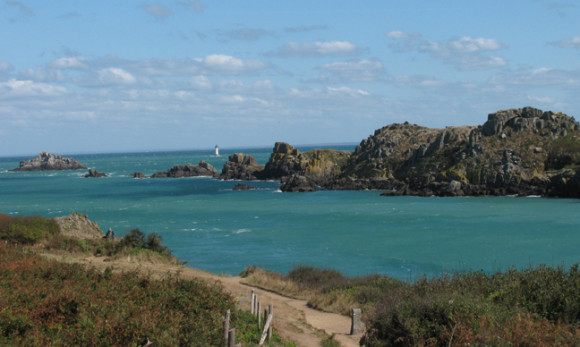
In which Henri and I explore the Emerald Coast of Brittany from Saint Malo to Cancale by way of Jacques Cartier’s house, the sculpted rocks near Rothéneuf and the Point du Grouin.
On our way from Paris to Brittany Henri and I had talked a lot about what we should bring as a gift for the women who as putting us up for the weekend. We’d never met her. She was the neighbor of the friends who was having the party on Saturday and she had told them that she had extra room if any of the guests were reluctant to spring for a hotel. She didn’t actually say that last part but our friends immediately thought of me and Henri. We’d considered bringing chocolates, Champagne, or flowers as a house gift, finally deciding on flowers, but we arrived too late to buy them so we greeted her empty handed.
That wasn’t such a problem for me since I immediately complemented our host on her tchotchkes and her red Louis Vuitton handbag so as to reassure her that she was hosting a man of good taste. But for Henri, who is the kind of Frenchman for whom etiquette, grammar, and knowing all about Madame de Pompadour are all that is left to distinguish those you would accept in your home from those you would only accept in your bed, arriving empty handed was akin to slap in the face—his own, that is, for he immediately turned red. Our hostess then further displayed excellent etiquette by opening a bottle of Champagne to welcome us.
If there was one thing I’d learned about Henri after 24 hours on the road it was that you can tell him to pose anywhere and he’ll do it. So here is Henri on his bed in the cheery room we’d been given.
Henri and I had never spent the night in the same room, so I took the bed by the door in case it turned out that Henri snores or has other uncontrollable and unpleasant nighttime habits that would require me shifting to the couch in the living room. Turns out he refrained from doing any such thing that night. We both slept well.
Brittany is famous for its ever-changing weather, whereby you’re told to run outside as soon as the sun shines because it may not last long. So immediately upon waking up and eating the breakfast that our hostess had prepared for us (further embarrassing Henri for not having a brought a gift) we got in the car and drove off, planning to find a gift along the way.
Our good fortune with the weather is also the reason that we bypassed Saint-Malo. It was far too nice out to spend our time on and within the granite ramparts of that famous rebuilt town that was once made wealthy from the workings of privateers and merchant ship owners and once made rubble in August 1944 by the workings of war.
So we leap-frogged Saint-Malo proper and headed to its suburban the coast by way of the Lemoëlou Manor, which once belonged to Jacques Cartier (1491-1557).

Cartier, you may remember from history class (particularly if you’re Canadian), left from Saint-Malo in 1534 to find a northern route to Asia and instead discovered Canada, which he claimed in the name of King Francis I. I’m writing this on Columbus Day and am aware that it is politically incorrect to say that Europeans discovered the Americas since there were already people here, but all traveling, I think, can be considered as discovery—or rediscovery—no matter how many people have been there before, so let’s all take a break with the anti-discovery crusade.
Not that that thought made me particularly anxious to visit Jacques Cartier’s house, now a museum that reveals manor life in these parts in the 16th century. We couldn’t have visited even if we wanted to because they were closing for lunch shortly after 11am even though the sign out front says that they close for lunch at 11:30. Still, an employee let us enter into the courtyard to take the above picture before she closed the gate and drove off for a 3-hour lunch.
The manor is located less than a mile inland from Rothéneuf. We followed the signs to Rochers Sculptés to see rocks along the cliff that had been sculpted into 300 characters by a priest named Abbé Adolphe Fouré (1839-1910). At age 55 he had a stroke, which left him deaf and mute yet able to wield a pick and hammer. He then withdrew to this windy corner of Brittany (actually, all corners of Brittany are windy) and set about sculpting the rock over an area of 5000 square feet into characters inspired by local legend.

Henri and I nearly turned back when we discovered that we had to pay 3€ each to climb on the rocks when nearly the entire coast of Brittany is full of rocks to climb on for free. But I felt a sense of investigative duty to see it since we were right there, so I sported up the 6€ and off we traipsed on the rocks. And I’m glad we did because now I can tell you that it isn’t worth driving out of your way to visit the Rochers Sculptés, however, if you ever do come this way and there aren’t more than a few other cars in the lot you might was well fork over the few euros and behold the monk’s work and have a climb on the rocks—at your own risk of breaking an ankle or being blown off the cliff in the wind, I might add.
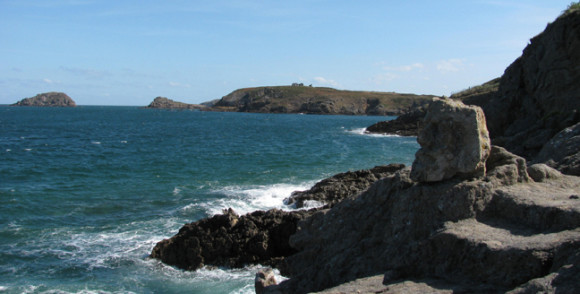
Afterwards we continued along the coast and stopped to admire some beautiful seascapes after that. Such as this:

and this
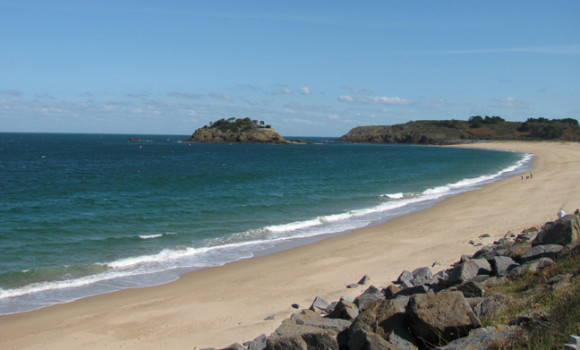
and this, where you’ll see why this is called the Emerald Coast.

We then drove to the Point de Grouin, which is the northeastern most point of the peninsula and in fact of all of Brittany considering that when you look out you see Normandy.
After parking our car, we couldn’t agree on which path to take out to the point. Henri wanted to take the high road out and I wanted to take the low road, which pretty much sums up the difference between us, and unwilling to fathom a compromise in which one of us would have to give in and the other one smirk, we separated, which was just as well because after a couple of hours with Henri a little break is always welcome.

I eventually found Henri back near the car (I had the keys). I could tell by the way he asked what had taken me so long that he had either missed me or had taken the less interesting path. When I asked him if he’d seen Le Mont Saint Michel in the distance he nodded “Mm” in such a way that I knew he was lying. Here’s Le Mont Saint Michel beyond the rocks:
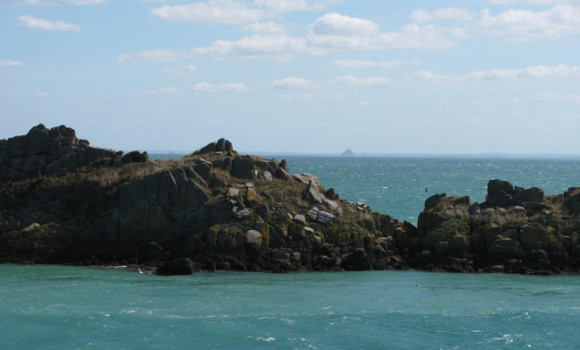
We then stopped at Cancale. I’d been here briefly on a weekday in early June this year when there wasn’t a tourist in sight and found it a wonderfully charming little port town where I wish I’d been able to spend more than an hour. Now, on a sunny September weekend it was quite crowded, and even though I didn’t feel the need to stay for long I was very glad that I did have another hour here.
Cancale, which faces the bay of Le Mont Saint Michel and finally afforded Henri a distant glimpse of the Mount, is famous for its oysters, which enjoy the refreshing current of some of the strongest tides in the world. The Cancale is a firm, salty everyman’s oyster that makes its way onto tables throughout France, especially during the Christmas-New Year season.
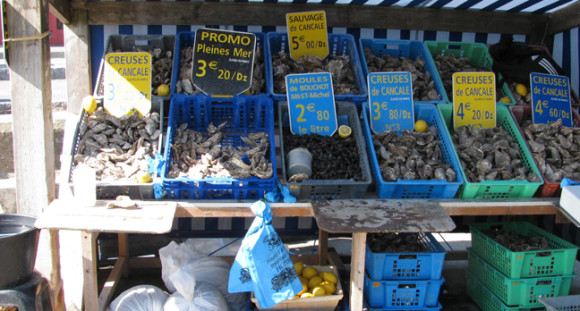
To best appreciate Cancale oysters in Cancale you should go directly to the oystermongers at the northern end of the port and ask them to open up a dozen that you can then down (with a spritz of lemon) on the ledge with a view out to the oyster farms and, on a bright day, Le Mont Saint Michel in the distance.
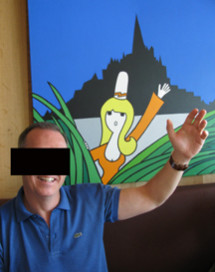
Henri and I would have done just that if we’d known the stands were there before we took a seat in a creperie. No regrets, though. We enjoyed the crepes, which are also very much a part of Brittany. Henri was feeling particularly Breton by the time we left.
We were so happy with our little excursion that it wasn’t until we got back to the house in Dinard that we realized that we’d yet to get a thank-you gift for our hostess. We didn’t have time go back out though as we had a party to dress for.
(c) 2009, Gary Lee Kraut.

